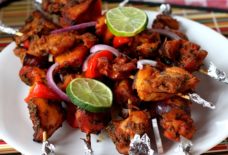The Tasty and Nourishing Chickpea
By: Habeeb Salloum/ Arab America Contributing Writer
Neither a pea nor a bean, yet, combining the best qualities of both, the chickpea is fast catching on in almost every country of the world. Virtually unknown in North America a half century ago, this delectable legume is today found on the shelves of the supermarkets and ethnic food outlets throughout Canada and the U.S.A. Delicious as an ingredient in numerous types of dishes, this culinary delight with a nut-like flavour is becoming, to some extent, an essential part of the North American cuisine.
The original home of the chickpea is believed to be in the lands touching on the eastern Mediterranean. From there, its cultivation spread eastward to the whole of Asia and westward to the Iberian Peninsula. When the Spaniards conquered much of the New World they introduced the plant into the Americas.
In the ensuing centuries, a number of countries in South and Central America became large chickpea producers. Today, in addition to these lands, the states edging the Mediterranean and the Indian subcontinent grow most of the world’s supply of this legume.
To thrive chickpeas need a semi-arid sandy soil. Hence, the countries of the Middle East, North Africa and parts of southern Europe are ideal for their cultivation. In these lands of early civilizations they have been employed in countless dishes since the dawn of history. In Mexico and several other Latin American countries they have been on the everyday menu from the era of the conquistadors. On the other hand, in North America, the plant was grown during the last few centuries in the southern U.S.A. as feed for cattle and hogs. It has been only in our times that chickpeas have become a common everyday food product in Canada and the U.S.A.
Although not commonly known, the dry western Canadian and American prairies are well suited for the cultivation of this hardy Mediterranean vegetable. Early in this century when my parents homesteaded in southern Saskatchewan, they planted year after year gardens overflowing with chickpeas. In the all-encompassing drought of the Depression years when hardly any grains or vegetables grew and people went hungry, we thrived on our dishes of chickpeas. Today, in parts of that western Canadian province they are planted on a commercial scale – a far cry from the days of my youth when chickpeas as a food were unknown.
The bushy chickpea plant annually grows to a height of two feet. It produces small white or pinkish flowers and dozens of pods, each containing one or two round seeds ranging in colours from pinkish-white to black. The shape of the plant makes it ideal for cultivation with modern machinery. This, and the near perfect soil and climate of the prairies guarantees it a bright future on the mechanized western farms of North America.
Chickpea and Yogurt PlatterChickpeas are a healthy food source, containing a good amount of zinc, calcium and protein. As well, and they are high in dietary fibre and an excellent source of healthy mono-unsaturated fats and are low-glycaemia carbohydrates.
For centuries a staple in Middle-Eastern and Mediterranean-style diets, Chickpeas add a burst of mouth-watering flavours to plain-tasting foods and make a pleasant change from pastas, potatoes and rice, chickpeas can be prepared and served in numerous ways. The mature pods, when still green, can be roasted, then peeled and served as appetizers or stripped and utilized raw in cooking in the same manner as green peas. However, although delicious when eaten green, chickpeas are not generally consumed in this fashion. In most cases they are harvested when fully matured and dried. Like dried beans and peas they make an excellent ingredient in all types of soups and stews.
The peasants of the Mediterranean countries, perhaps due to insufficient income, developed a series of tantalizing dishes utilizing this legume. For many centuries chickpeas have been employed as a replacement for meat in soups, stews and stuffing. In food value, taste and texture these peasant dishes are unequalled in the vegetable kitchens of the world. Today vegetarians in all parts of the globe can enjoy these appetizing culinary delights.
In a number of Middle Eastern and North African countries, in addition to being used as a food, there are other benefits attributed to chickpeas. In the North African countries where they are employed extensively in cooking, many believe that chickpeas increase the energy and sexual desires of both men and women. Shaykh `Umar Abu Muhammad, a 16th century North African Arab writer, in his book The Perfumed Garden, suggests chickpeas as a cure for impotence and a first-rate sexual stimulant. In the eastern Arab lands, the peasants are convinced that it has qualities, which give them the essential energy necessary for their lives of toil. Even if modern man scoffs at these claims and calls them old wives tales, they nevertheless have been firmly believed for centuries.
Chickpea FrittersIn North America, chickpeas can be found in supermarkets and Arab, Armenian, Greek, Indian, Italian and Spanish food stores. Notwithstanding the fact that their common name in the English-speaking world is chickpeas they are also sold under their Italian name ceci; Arabic hummus; or Spanish garbanzo.
They are to be found in bulk, packages or cooked in cans. Also, they can be purchased candied or roasted for appetizers and snacks .
Consumed in whatever form, chickpeas, especially to a vegetarian are, when compared to other legumes, without equal. In availability, price, food value, flexibility in cooking, and taste, they stand near the top when compared to their sister legumes. There is no better way to prove this fact than by an uninitiated fine food explorer plunging into the realm of the tasty and nourishing chickpea.







